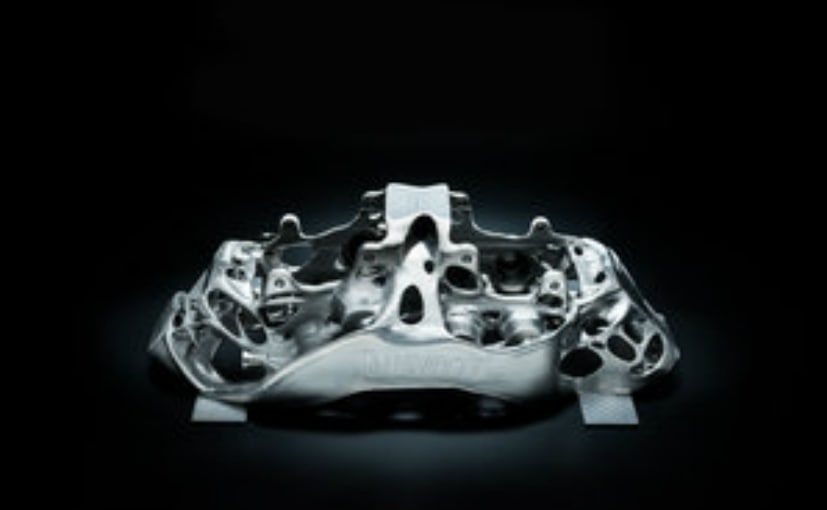Bugatti Develops World's First Brake Caliper By 3-D Printer

The Development Department of Bugatti, for the first time, has developed a brake caliper that can be produced by 3-D printing. While the main material used for the additive production of vehicle components to date has been aluminum; the new brake caliper is made from titanium, making it the world's largest functional component produced from titanium using 3-D printing processes. The French car-makers collaborated with Laser Zentrum Nord of Hamburg to develop these new brake calipers, who have been working on this since the beginning of the year. Vehicle trials for the use of the 3-D titanium brake caliper in series production are to start in the first half of the year.
Also Read: Bugatti Announces Worldwide Recall Of Chiron. Here's Why
Frank Gotzke, Head of New Technologies, Technical Development Department, Bugatti Automobiles S.A.S said, "Vehicle development is a never-ending process. This is particularly true at Bugatti. In our continuing development efforts, we are always considering how new materials and processes can be used to make our current model even better and how future vehicles of our brand could be designed."

(Bugatti currently uses the most powerful brakes in the world on the new Chiron)
Bugatti currently uses the most powerful brakes in the world on the new Chiron. The brake calipers were an entirely new development. They are forged from a block of high-strength aluminum alloy. With eight titanium pistons on each of the front calipers and six on each of the rear units, these are also the largest brake calipers currently installed on a production vehicle. The brake calipers of the Chiron are produced using bionic principles on the basis of a natural model. The new architecture combines minimum weight with maximum stiffness. The new titanium brake caliper weighs about 2.9 kg, while the aluminum component currently used, weighs 4.9 kg.
Also Read: Bugatti Chiron Sets World Record In Under 42 Seconds
Gotzke added, "In terms of volume, this is the largest functional component produced from titanium by additive manufacturing methods. Everyone who looks at the part is surprised at how light it is - despite its large size. Technically, this is an extremely impressive brake caliper, and it also looks great."
The development time for the 3-D-printed titanium brake caliper took about three months, from conceptualizing to the production of first printed component. The basic concept was sent to Laser Zentrum Nord as a complete data package. They then carried out the process simulation, the design of the supporting structures, actual printing and the treatment of the component. Bugatti was responsible for finishing.
Latest News
 Jaiveer Mehra | Jan 6, 2026Mahindra XUV 3XO EV Launched In India; Prices Start At Rs 13.89 LakhEssentially the successor to the XUV 400 EV, the 3XO EV is offered in two trim levels and solely with a 39.4 kWh battery.1 min read
Jaiveer Mehra | Jan 6, 2026Mahindra XUV 3XO EV Launched In India; Prices Start At Rs 13.89 LakhEssentially the successor to the XUV 400 EV, the 3XO EV is offered in two trim levels and solely with a 39.4 kWh battery.1 min read Jaiveer Mehra | Jan 6, 2026Nissan Tekton SUV World Premiere On February 4The Tekton will make its debut hot on the heels of the Gravite and will share its platform with the upcoming new Duster.1 min read
Jaiveer Mehra | Jan 6, 2026Nissan Tekton SUV World Premiere On February 4The Tekton will make its debut hot on the heels of the Gravite and will share its platform with the upcoming new Duster.1 min read car&bike Team | Jan 6, 2026New Bajaj Chetak With Hub Motor To Be Launched On January 14Expected to be positioned as a more affordable derivative of the iconic Bajaj scooter, the newest member of the Chetak family will be targeted at the TVS Orbiter and Vida VX2.2 mins read
car&bike Team | Jan 6, 2026New Bajaj Chetak With Hub Motor To Be Launched On January 14Expected to be positioned as a more affordable derivative of the iconic Bajaj scooter, the newest member of the Chetak family will be targeted at the TVS Orbiter and Vida VX2.2 mins read Jaiveer Mehra | Jan 6, 2026Nissan Gravite MPV To Debut On January 21B-segment MPV to share its underpinnings and powertrain options with the Renault Triber.1 min read
Jaiveer Mehra | Jan 6, 2026Nissan Gravite MPV To Debut On January 21B-segment MPV to share its underpinnings and powertrain options with the Renault Triber.1 min read Jaiveer Mehra | Jan 6, 2026Mahindra XUV 7XO Prices, Variants ExplainedFacelifted SUV is offered in a choice of six variants and with petrol and diesel engine options.1 min read
Jaiveer Mehra | Jan 6, 2026Mahindra XUV 7XO Prices, Variants ExplainedFacelifted SUV is offered in a choice of six variants and with petrol and diesel engine options.1 min read car&bike Team | Jan 5, 2026Updated Simple One Electric Scooter Launched At Rs 1.50 Lakh; 5 kWh Variant Promises Up To 265 KM RangeWith a series of changes made to the existing scooter, the start-up claims to have improved range, top speed as well as on-road behaviour of the Simple One.1 min read
car&bike Team | Jan 5, 2026Updated Simple One Electric Scooter Launched At Rs 1.50 Lakh; 5 kWh Variant Promises Up To 265 KM RangeWith a series of changes made to the existing scooter, the start-up claims to have improved range, top speed as well as on-road behaviour of the Simple One.1 min read
 Amaan Ahmed | Jan 3, 2026VLF Mobster 135 300 KM Review: Fun But FlawedA 125 cc scooter with Italian design and Chinese genes is a rare combination, and while some may be tempted to dismiss it because of its origins, the VLF Mobster shows 125s can also be exciting – but not without compromises.11 mins read
Amaan Ahmed | Jan 3, 2026VLF Mobster 135 300 KM Review: Fun But FlawedA 125 cc scooter with Italian design and Chinese genes is a rare combination, and while some may be tempted to dismiss it because of its origins, the VLF Mobster shows 125s can also be exciting – but not without compromises.11 mins read Preetam Bora | Dec 30, 2025TVS Orbiter Review: Real-World Performance and Range TestedThe TVS Orbiter is a promising electric scooter promising decent range, practicality and pricing. But is there any reason to avoid it? We spent a few days getting to know it better.9 mins read
Preetam Bora | Dec 30, 2025TVS Orbiter Review: Real-World Performance and Range TestedThe TVS Orbiter is a promising electric scooter promising decent range, practicality and pricing. But is there any reason to avoid it? We spent a few days getting to know it better.9 mins read Jafar Rizvi | Dec 24, 2025MG Windsor EV 38 kWh Long-Term Report: IntroductionThe Windsor EV has joined our garage, and before it settles into daily duty, I took it out to get a sense of what living with an electric car is like.4 mins read
Jafar Rizvi | Dec 24, 2025MG Windsor EV 38 kWh Long-Term Report: IntroductionThe Windsor EV has joined our garage, and before it settles into daily duty, I took it out to get a sense of what living with an electric car is like.4 mins read Seshan Vijayraghvan | Dec 23, 20252026 Kia Seltos Review: Formula Is Spot On, But Is The Timing Right?The 2nd-gen Kia Seltos has arrived, but it has the challenge of facing strong rivals like the Victoris and Sierra. The question is simple - Does it still have what it takes?9 mins read
Seshan Vijayraghvan | Dec 23, 20252026 Kia Seltos Review: Formula Is Spot On, But Is The Timing Right?The 2nd-gen Kia Seltos has arrived, but it has the challenge of facing strong rivals like the Victoris and Sierra. The question is simple - Does it still have what it takes?9 mins read car&bike Team | Dec 26, 2025Tata Punch EV Long-Term Second Report: Highway Performance, Pros & ConsAfter a week of living with the Tata Punch EV Long Range—including a proper Mumbai-Nashik highway test—we've learned what this little electric SUV is really made of.1 min read
car&bike Team | Dec 26, 2025Tata Punch EV Long-Term Second Report: Highway Performance, Pros & ConsAfter a week of living with the Tata Punch EV Long Range—including a proper Mumbai-Nashik highway test—we've learned what this little electric SUV is really made of.1 min read






















































































































